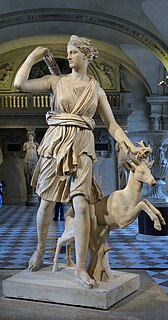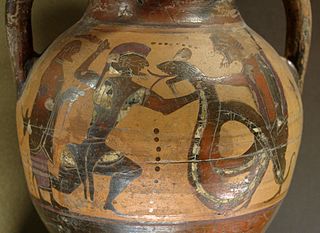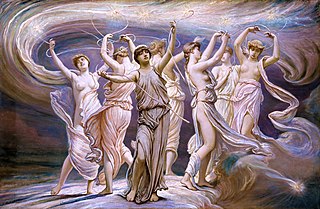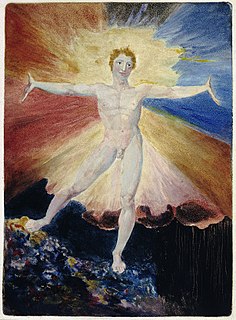Related Research Articles

In Greek mythology, the Amazons are portrayed in a number of ancient epic poems and legends, such as the Labours of Hercules, the Argonautica and the Iliad. They were a group of female warriors and hunters, who matched men in physical agility and strength, in archery, riding skills and the arts of combat. Their society was closed for men and they only raised their daughters, either killing their sons or returning them to their fathers, with whom they would only socialize briefly in order to reproduce.

Artemis is the Greek goddess of the hunt, the wilderness, wild animals, the Moon, and chastity. The goddess Diana is her Roman equivalent.

Hera is the goddess of women, marriage, family and childbirth in ancient Greek religion and mythology, one of the twelve Olympians and the sister and wife of Zeus. She is the daughter of the Titans Cronus and Rhea. Hera rules over Mount Olympus as queen of the gods. A matronly figure, Hera served as both the patroness and protectress of married women, presiding over weddings and blessing marital unions. One of Hera's defining characteristics is her jealous and vengeful nature against Zeus' numerous lovers and illegitimate offspring, as well as the mortals who cross her.

Heracles, born Alcaeus or Alcides, was a divine hero in Greek mythology, the son of Zeus and Alcmene, and the foster son of Amphitryon. He was a great-grandson and half-brother of Perseus, and similarly a half-brother of Dionysus. He was the greatest of the Greek heroes, the ancestor of royal clans who claimed to be Heracleidae (Ἡρακλεῖδαι), and a champion of the Olympian order against chthonic monsters. In Rome and the modern West, he is known as Hercules, with whom the later Roman emperors, in particular Commodus and Maximian, often identified themselves. The Romans adopted the Greek version of his life and works essentially unchanged, but added anecdotal detail of their own, some of it linking the hero with the geography of the Central Mediterranean. Details of his cult were adapted to Rome as well.

In Greek mythology, Leto is the mother of Apollo and Artemis. She is the daughter of the Titans Coeus and Phoebe, and the sister of Asteria.

In Greek and Roman mythology, the Giants, also called Gigantes, were a race of great strength and aggression, though not necessarily of great size. They were known for the Gigantomachy, their battle with the Olympian gods. According to Hesiod, the Giants were the offspring of Gaia (Earth), born from the blood that fell when Uranus (Sky) was castrated by his Titan son Cronus.

In Greek mythology, Alcyoneus or Alkyoneus was a traditional opponent of the hero Heracles. He was usually considered to be one of the Gigantes (Giants), the offspring of Gaia born from the blood of the castrated Uranus.

Clotho is a mythological figure. She is the one of the Three Fates or Moirai who spins the thread of human life; the other two draw out (Lachesis) and cut (Atropos) in ancient Greek mythology. Her Roman equivalent is Nona. She also made major decisions, such as when a person was born, thus in effect controlling people's lives. This power enabled her not only to choose who was born, but also to decide when gods or mortals were to be saved or put to death. For example, Clotho brought Pelops back to life when his father killed him.

In Classical Greek mythology, Taygete was a nymph, one of the Pleiades according to the Bibliotheca (3.10.1) and a companion of Artemis, in her archaic role as potnia theron, "Mistress of the animals", with its likely roots in prehistory. Mount Taygetos in Laconia, dedicated to the goddess, was her haunt.
In Greek mythology, Iasus or Iasius was the name of several people:
In Greek mythology, Melanippe referred to several different people:

In Greek mythology, Orion was a giant huntsman whom Zeus placed among the stars as the constellation of Orion.

In ancient Greek religion and mythology, the twelve Olympians are the major deities of the Greek pantheon, commonly considered to be Zeus, Hera, Poseidon, Demeter, Athena, Apollo, Artemis, Ares, Hephaestus, Aphrodite, Hermes, and either Hestia or Dionysus. They were called Olympians because, according to tradition, they resided on Mount Olympus.

In the mythology of William Blake, Albion is the primeval man whose fall and division results in the Four Zoas: Urizen, Tharmas, Luvah/Orc and Urthona/Los. The name derives from the ancient and mythological name of Britain, Albion.
The Twelve Labours of Heracles are a series of episodes concerning a penance carried out by Heracles, the greatest of the Greek heroes, whose name was later romanised as Hercules. They were accomplished at the service of King Eurystheus. The episodes were later connected by a continuous narrative.

The Siphnian Treasury was a building at the Ancient Greek cult centre of Delphi, erected to host the offerings of the polis, or city-state, of Siphnos. It was one of a number of treasuries lining the "Sacred Way", the processional route through the Sanctuary of Apollo, erected to win the favor of the gods and increase the prestige of the donor polis. It was one of the earlier surviving buildings of this type, and its date remains a matter for debate, with the most plausible date being around 525 BC. Until recently it was often confused or conflated with the neighbouring Cnidian Treasury, a similar but less elaborate building, as the remains of the two had become mixed together and earlier theoretical reconstructions used parts of both.

Dragons play a significant role in Greek mythology. Though the Greek drakōn often differs from the modern Western conception of a dragon, it is both the etymological origin of the modern term and the source of many surviving Indo-European myths and legends about dragons.

Themiscyra was an ancient Greek town in northeastern Anatolia; it was situated on the southern coast of the Black Sea, near the mouth of the Thermodon, probably at or near modern Terme.

In Greek mythology, Merope is one of the seven Pleiades, daughters of Atlas and Pleione. Pleione, their mother, is the daughter of Oceanus and Tethys and is the protector of sailors. Their transformation into the star cluster known as the Pleiades is the subject of various myths.

Greek mythology is the body of myths originally told by the ancient Greeks, and a genre of Ancient Greek folklore. These stories concern the origin and nature of the world, the lives and activities of deities, heroes, and mythological creatures, and the origins and significance of the ancient Greeks' own cult and ritual practices. Modern scholars study the myths to shed light on the religious and political institutions of ancient Greece, and to better understand the nature of myth-making itself.
References
- 1 2 Bane, Theresa (2016-05-12). Encyclopedia of Giants and Humanoids in Myth, Legend and Folklore. McFarland. p. 79. ISBN 978-1-4766-6351-7.
- 1 2 Frazer 1921, note 1 to Apollodorus 1.6.2, p. 46: "Γρατίωνα probably corrupt. Various emendations have been suggested, as Αἰγαίωνα (Heyne, M. Mayer, op. cit. pp. 201 sq.), Εὐρυτίωνα, Ῥαίωνα (Hercher)."
- ↑ Grimal, s.v. Artemis, p. 61.
- ↑ Salisbury, Joyce E. (2001). Encyclopedia of Women in the Ancient World. ABC-CLIO. p. 19. ISBN 978-1-57607-092-5.
- ↑ Coulter, Charles Russell; Turner, Patricia (2013-07-04). Encyclopedia of Ancient Deities. Routledge. p. 79. ISBN 978-1-135-96390-3.
- ↑ Bulfinch, Thomas (2012-03-05). Bulfinch's Greek and Roman Mythology: The Age of Fable. Courier Corporation. p. 117. ISBN 978-0-486-11487-3.